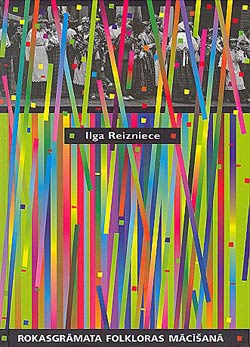
Latvian folklore was traditionally passed down from one generation to the next via family traditions. These traditions have, over the centuries, unfortunately lost their relevance in daily life, so the passing down of Latvia’s cultural heritage has largely been left to schools and community groups. Their efforts now may be aided by a new book, Rokasgrāmata folkloras mācīšanā, by Ilga Reizniece.
Not all Latvian schools both in Latvia and outside of it teach Latvian culture as part of their curriculum. Some schools, however, have included some elements of Latvian folklore in their school traditions.
Our children, who are attending school in Rīga since Sept. 1, have come across two such celebrations so far: Mikeļdiena and Mārtiņdiena. Mikeļdiena celebrations were marked by fruit and vegetable sculptures created by the children (and in many cases, the parents) and displayed in the school yard, while Mārtiņdiena was the day the children from the older grades sold homemade items to the younger kids. I asked the children if any of the teachers had explained anything more about these days that are of important ritual significance in the ancient Latvian solar calendar. “Nē”, they both replied, not much more had been explained. The younger children had painted a rooster (the traditional fare for Mārtiņdiena feasts) in art class, so I guess that was as far as the teachers wanted to go with this topic.
Some schools in Latvia, such as the Jūrmala Alternative School not far from Rīga, have embraced Latvian traditions fully with folklore lessons part of the school’s curriculum. One of the educators at this school is Reizniece, best known as the lead singer and violinist for the post-folklore band Iļģi. Reizniece is a person with boundless energy and a passion—and a gift—for the passing of Latvian traditions on to the younger generation. In the past 15 years many books have been published on the subject of Latvian folklore. Some have actually had content that is very similar to what you will find in this book—Latvian children’s games with music and actions, songs, skaitāmpantņii (children’s verses)—but this book goes one step further.
Although it is in Latvian, the book is an easy read, so don’t fret if you think your Latvian will not be strong enough to follow the text. The tone of the book is informal and chatty, making you feel that Reizniece is talking to you directly. She relays some interesting stories from her folklore “lessons” (it seems more fitting to call them “sessions of fun and games”). Reizniece has not only included a huge variety of traditions and grouped them by season (as is usually the case when teaching traditions), but has done it in such a loving and playful way that you almost want to run out yourself, find some children and start singing and dancing with them to your heart’s content!
The seasonal approach is not the only way the traditions have been grouped. There’s a section on lullabies, sun songs, Latvian mythology in general, jokes, folksongs about mothers, birds and so forth. The sheer variety of ideas would be a delight to anyone teaching the subject in a weekly school situation as you would be guaranteed a lesson every week for the whole school year with many topics left over. The book is not meant as a curriculum. It is more a treasure chest of suggestions that can be adapted to suit the situation at hand.
Rokasgrāmata folkloras mācīšanā is practical as it recognizes that the concepts portrayed in these traditions are hard to explain to kids who live in the 21st century where technology rules and contact with an agricultural lifestyle is minimal. Reizniece has drawn from many years’ experience with children of all ages and has come up with her own solutions to this problem. Another positive element is that reference is made to other media as potential resources for teachers: the Web, videotapes and DVDs, and excursions to specific museums in Latvia, such as the Ethnographic Open Air Museum, Latvišu Folkloras krštuve (Archives of Latvian Folklore) or the Krišjāņa Barona muzejs.
The book can be used by parents or grandparents and incorported into their own family traditions. This doesn’t necessarily have to mean it is “taught” to children by an educator in the classical sense. It also is great to read even if you don’t come into contact with children in your day-to-day life. You can learn a great deal about the world view of the ancestors of modern-day Latvians from the explanations of these simple children’s songs and games.
Details
Rokasgrāmata folkloras mācīšanā
Ilga Reizniece
Rīga: Zvaigzne ABC, 2006
ISBN 9984-37-509-9
Where to buy
Purchase Rokasgrāmata folkloras mācīšanā from BalticShop.
Note: Latvians Online receives a commission on purchases.
© 1995-2024 Latvians Online
Please contact us for editorial queries, or for permission to republish material. Disclaimer: The content of Web sites to which Latvians Online provides links does not necessarily reflect the opinion of Latvians Online, its staff or its sponsors.




